

CompletableFuture原理与实践-外卖商家端API的异步化-51CTO.COM
source link: https://developer.51cto.com/article/708912.html
Go to the source link to view the article. You can view the picture content, updated content and better typesetting reading experience. If the link is broken, please click the button below to view the snapshot at that time.
CompletableFuture原理与实践-外卖商家端API的异步化-51CTO.COM
作者 | 长发 旭孟 向鹏
CompletableFuture由Java 8提供,是实现异步化的工具类,上手难度较低,且功能强大,支持通过函数式编程的方式对各类操作进行组合编排。相比于ListenableFuture,CompletableFuture有效提升了代码的可读性,解决了“回调地狱”的问题。本文主要讲述CompletableFuture的原理与实践,同时结合了美团外卖商家端API的异步化实战,希望能对从事相关开发的同学有所帮助或启发。
随着订单量的持续上升,美团外卖各系统服务面临的压力也越来越大。作为外卖链路的核心环节,商家端提供了商家接单、配送等一系列核心功能,业务对系统吞吐量的要求也越来越高。而商家端API服务是流量入口,所有商家端流量都会由其调度、聚合,对外面向商家提供功能接口,对内调度各个下游服务获取数据进行聚合,具有鲜明的I/O密集型(I/O Bound)特点。在当前日订单规模已达千万级的情况下,使用同步加载方式的弊端逐渐显现,因此我们开始考虑将同步加载改为并行加载的可行性。
1 为何需要并行加载
外卖商家端API服务是典型的I/O密集型(I/O Bound)服务。除此之外,美团外卖商家端交易业务还有两个比较大的特点:
- 服务端必须一次返回订单卡片所有内容:根据商家端和服务端的“增量同步协议注1”,服务端必须一次性返回订单的所有信息,包含订单主信息、商品、结算、配送、用户信息、骑手信息、餐损、退款、客服赔付(参照下面订单卡片截图)等,需要从下游三十多个服务中获取数据。在特定条件下,如第一次登录和长时间没登录的情况下,客户端会分页拉取多个订单,这样发起的远程调用会更多。
- 商家端和服务端交互频繁:商家对订单状态变化敏感,多种推拉机制保证每次变更能够触达商家,导致App和服务端的交互频繁,每次变更需要拉取订单最新的全部内容。
在外卖交易链路如此大的流量下,为了保证商家的用户体验,保证接口的高性能,并行从下游获取数据就成为必然。
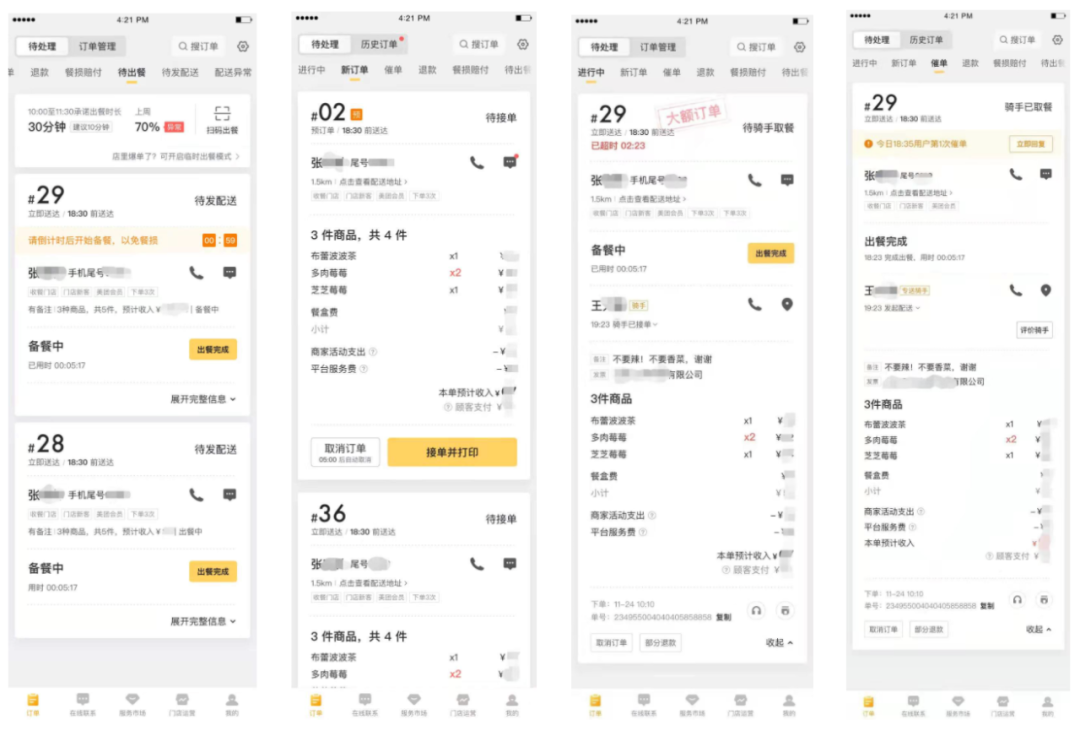
图1 订单卡片
2 并行加载的实现方式
并行从下游获取数据,从IO模型上来讲分为同步模型和异步模型。
2.1 同步模型
从各个服务获取数据最常见的是同步调用,如下图所示:
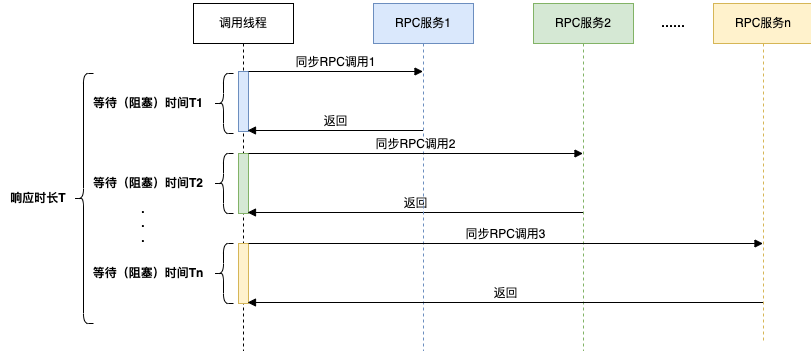
图2 同步调用
在同步调用的场景下,接口耗时长、性能差,接口响应时长T > T1+T2+T3+……+Tn,这时为了缩短接口的响应时间,一般会使用线程池的方式并行获取数据,商家端订单卡片的组装正是使用了这种方式。
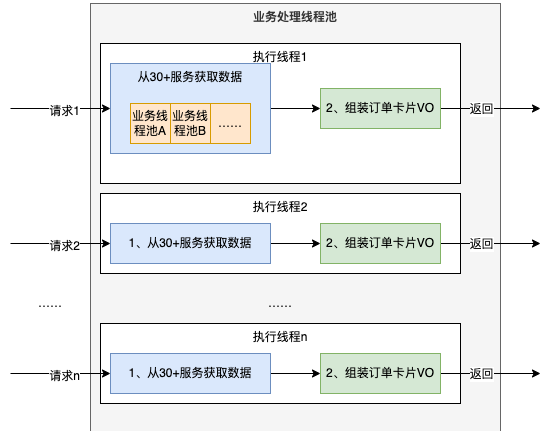
图3 并行之线程池
这种方式由于以下两个原因,导致资源利用率比较低:
- CPU资源大量浪费在阻塞等待上,导致CPU资源利用率低。在Java 8之前,一般会通过回调的方式来减少阻塞,但是大量使用回调,又引发臭名昭著的回调地狱问题,导致代码可读性和可维护性大大降低。
- 为了增加并发度,会引入更多额外的线程池,随着CPU调度线程数的增加,会导致更严重的资源争用,宝贵的CPU资源被损耗在上下文切换上,而且线程本身也会占用系统资源,且不能无限增加。
同步模型下,会导致硬件资源无法充分利用,系统吞吐量容易达到瓶颈。
2.2 NIO异步模型
我们主要通过以下两种方式来减少线程池的调度开销和阻塞时间:
- 通过RPC NIO异步调用的方式可以降低线程数,从而降低调度(上下文切换)开销,如Dubbo的异步调用可以参考《dubbo调用端异步》一文。
- 通过引入CompletableFuture(下文简称CF)对业务流程进行编排,降低依赖之间的阻塞。本文主要讲述CompletableFuture的使用和原理。
2.3 为什么会选择CompletableFuture?
我们首先对业界广泛流行的解决方案做了横向调研,主要包括Future、CompletableFuture注2、RxJava、Reactor。它们的特性对比如下:
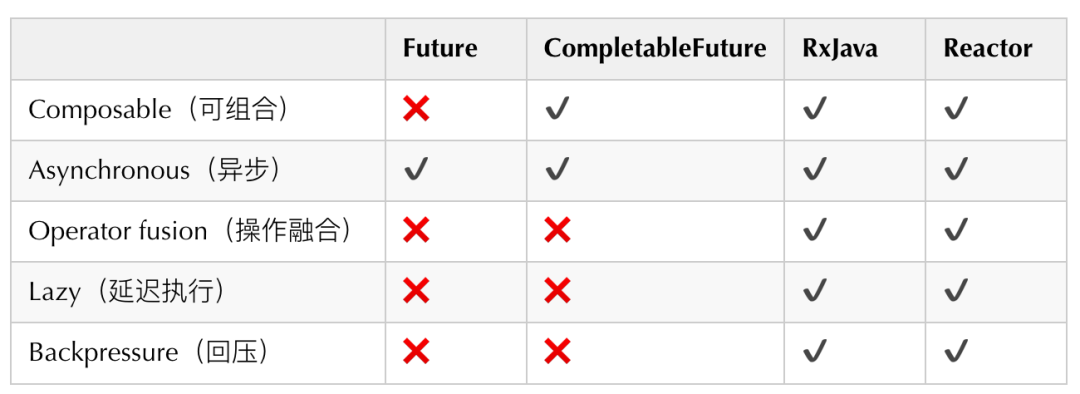
- 可组合:可以将多个依赖操作通过不同的方式进行编排,例如CompletableFuture提供thenCompose、thenCombine等各种then开头的方法,这些方法就是对“可组合”特性的支持。
- 操作融合:将数据流中使用的多个操作符以某种方式结合起来,进而降低开销(时间、内存)。
- 延迟执行:操作不会立即执行,当收到明确指示时操作才会触发。例如Reactor只有当有订阅者订阅时,才会触发操作。
- 回压:某些异步阶段的处理速度跟不上,直接失败会导致大量数据的丢失,对业务来说是不能接受的,这时需要反馈上游生产者降低调用量。
RxJava与Reactor显然更加强大,它们提供了更多的函数调用方式,支持更多特性,但同时也带来了更大的学习成本。而我们本次整合最需要的特性就是“异步”、“可组合”,综合考虑后,我们选择了学习成本相对较低的CompletableFuture。
3 CompletableFuture使用与原理
3.1 CompletableFuture的背景和定义
3.1.1 CompletableFuture解决的问题
CompletableFuture是由Java 8引入的,在Java8之前我们一般通过Future实现异步。
- Future用于表示异步计算的结果,只能通过阻塞或者轮询的方式获取结果,而且不支持设置回调方法,Java 8之前若要设置回调一般会使用guava的ListenableFuture,回调的引入又会导致臭名昭著的回调地狱(下面的例子会通过ListenableFuture的使用来具体进行展示)。
- CompletableFuture对Future进行了扩展,可以通过设置回调的方式处理计算结果,同时也支持组合操作,支持进一步的编排,同时一定程度解决了回调地狱的问题。
下面将举例来说明,我们通过ListenableFuture、CompletableFuture来实现异步的差异。假设有三个操作step1、step2、step3存在依赖关系,其中step3的执行依赖step1和step2的结果。Future(ListenableFuture)的实现(回调地狱)如下:
ExecutorService executor = Executors.newFixedThreadPool(5);
ListeningExecutorService guavaExecutor = MoreExecutors.listeningDecorator(executor);ListenableFuture<String> future1 = guavaExecutor.submit(() -> {
//step 1
System.out.println("执行step 1");
return "step1 result";
});
ListenableFuture<String> future2 = guavaExecutor.submit(() -> {
//step 2
System.out.println("执行step 2");
return "step2 result";
});
ListenableFuture<List<String>> future1And2 = Futures.allAsList(future1, future2);
Futures.addCallback(future1And2, new FutureCallback<List<String>>() {
@Override
public void onSuccess(List<String> result) {
System.out.println(result);
ListenableFuture<String> future3 = guavaExecutor.submit(() -> {
System.out.println("执行step 3");
return "step3 result";
});
Futures.addCallback(future3, new FutureCallback<String>() {
@Override
public void onSuccess(String result) {
System.out.println(result);
}
@Override
public void onFailure(Throwable t) {
}
}, guavaExecutor);
}
@Override
public void onFailure(Throwable t) {
}}, guavaExecutor);
CompletableFuture的实现如下:
ExecutorService executor = Executors.newFixedThreadPool(5);
CompletableFuture<String> cf1 = CompletableFuture.supplyAsync(() -> {
System.out.println("执行step 1");
return "step1 result";
}, executor);
CompletableFuture<String> cf2 = CompletableFuture.supplyAsync(() -> {
System.out.println("执行step 2");
return "step2 result";
});
cf1.thenCombine(cf2, (result1, result2) -> {
System.out.println(result1 + " , " + result2);
System.out.println("执行step 3");
return "step3 result";
}).thenAccept(result3 -> System.out.println(result3));
显然,CompletableFuture的实现更为简洁,可读性更好。
3.1.2 CompletableFuture的定义
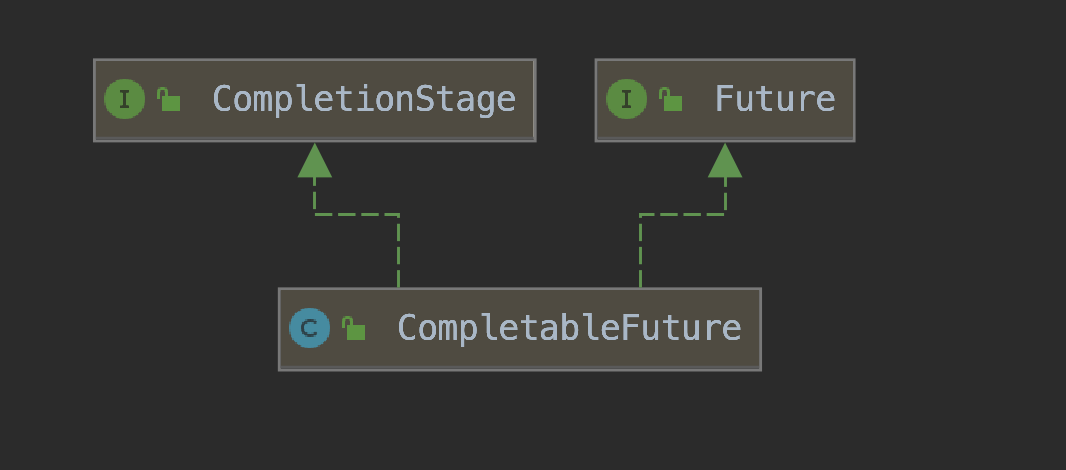
图4 CompletableFuture的定义
CompletableFuture实现了两个接口(如上图所示):Future、CompletionStage。Future表示异步计算的结果,CompletionStage用于表示异步执行过程中的一个步骤(Stage),这个步骤可能是由另外一个CompletionStage触发的,随着当前步骤的完成,也可能会触发其他一系列CompletionStage的执行。从而我们可以根据实际业务对这些步骤进行多样化的编排组合,CompletionStage接口正是定义了这样的能力,我们可以通过其提供的thenAppy、thenCompose等函数式编程方法来组合编排这些步骤。
3.2 CompletableFuture的使用
下面我们通过一个例子来讲解CompletableFuture如何使用,使用CompletableFuture也是构建依赖树的过程。一个CompletableFuture的完成会触发另外一系列依赖它的CompletableFuture的执行:
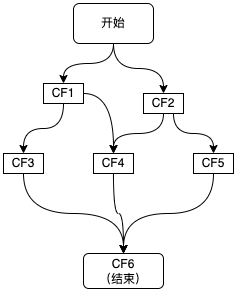
图5 请求执行流程
如上图所示,这里描绘的是一个业务接口的流程,其中包括CF1\CF2\CF3\CF4\CF5共5个步骤,并描绘了这些步骤之间的依赖关系,每个步骤可以是一次RPC调用、一次数据库操作或者是一次本地方法调用等,在使用CompletableFuture进行异步化编程时,图中的每个步骤都会产生一个CompletableFuture对象,最终结果也会用一个CompletableFuture来进行表示。根据CompletableFuture依赖数量,可以分为以下几类:零依赖、一元依赖、二元依赖和多元依赖。
3.2.1 零依赖:CompletableFuture的创建
我们先看下如何不依赖其他CompletableFuture来创建新的CompletableFuture:
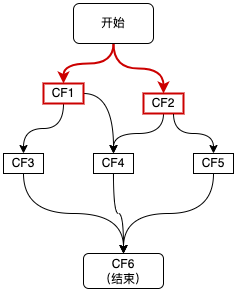
图6 零依赖如上图红色链路所示,接口接收到请求后,首先发起两个异步调用CF1、CF2,主要有三种方式:
ExecutorService executor = Executors.newFixedThreadPool(5);
//1、使用runAsync或supplyAsync发起异步调用
CompletableFuture<String> cf1 = CompletableFuture.supplyAsync(() -> {
return "result1";
}, executor);
//2、CompletableFuture.completedFuture()直接创建一个已完成状态的CompletableFuture
CompletableFuture<String> cf2 = CompletableFuture.completedFuture("result2");
//3、先初始化一个未完成的CompletableFuture,然后通过complete()、completeExceptionally(),完成该CompletableFuture
CompletableFuture<String> cf = new CompletableFuture<>();
cf.complete("success");第三种方式的一个典型使用场景,就是将回调方法转为CompletableFuture,然后再依赖CompletableFure的能力进行调用编排,示例如下:
@FunctionalInterface
public interface ThriftAsyncCall {
void invoke() throws TException;
}
/**
* 该方法为美团内部rpc注册监听的封装,可以作为其他实现的参照
* OctoThriftCallback 为thrift回调方法
* ThriftAsyncCall 为自定义函数,用来表示一次thrift调用(定义如上)
*/
public static <T> CompletableFuture<T> toCompletableFuture(final OctoThriftCallback<?,T> callback , ThriftAsyncCall thriftCall) {
//新建一个未完成的CompletableFuture
CompletableFuture<T> resultFuture = new CompletableFuture<>();
//监听回调的完成,并且与CompletableFuture同步状态
callback.addObserver(new OctoObserver<T>() {
@Override
public void onSuccess(T t) {
resultFuture.complete(t);
}
@Override
public void onFailure(Throwable throwable) {
resultFuture.completeExceptionally(throwable);
}
});
if (thriftCall != null) {
try {
thriftCall.invoke();
} catch (TException e) {
resultFuture.completeExceptionally(e);
}
}
return resultFuture;
}3.2.2 一元依赖:依赖一个CF
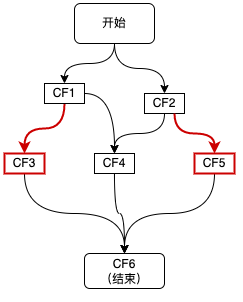
图7 一元依赖
如上图红色链路所示,CF3,CF5分别依赖于CF1和CF2,这种对于单个CompletableFuture的依赖可以通过thenApply、thenAccept、thenCompose等方法来实现,代码如下所示:
CompletableFuture<String> cf3 = cf1.thenApply(result1 -> {
//result1为CF1的结果
//......
return "result3";
});
CompletableFuture<String> cf5 = cf2.thenApply(result2 -> {
//result2为CF2的结果
//......
return "result5";
});3.2.3 二元依赖:依赖两个CF
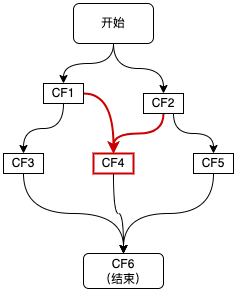
图8 二元依赖如上图红色链路所示,CF4同时依赖于两个CF1和CF2,这种二元依赖可以通过thenCombine等回调来实现,如下代码所示:
CompletableFuture<String> cf4 = cf1.thenCombine(cf2, (result1, result2) -> {
//result1和result2分别为cf1和cf2的结果
return "result4";
});3.2.4 多元依赖:依赖多个CF
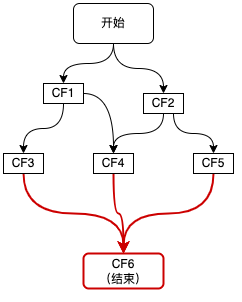
图9 多元依赖
如上图红色链路所示,整个流程的结束依赖于三个步骤CF3、CF4、CF5,这种多元依赖可以通过allOf或anyOf方法来实现,区别是当需要多个依赖全部完成时使用allOf,当多个依赖中的任意一个完成即可时使用anyOf,如下代码所示:
CompletableFuture<Void> cf6 = CompletableFuture.allOf(cf3, cf4, cf5);
CompletableFuture<String> result = cf6.thenApply(v -> {
//这里的join并不会阻塞,因为传给thenApply的函数是在CF3、CF4、CF5全部完成时,才会执行 。
result3 = cf3.join();
result4 = cf4.join();
result5 = cf5.join();
//根据result3、result4、result5组装最终result;
return "result";
});3.3 CompletableFuture原理
CompletableFuture中包含两个字段:result和stack。result用于存储当前CF的结果,stack(Completion)表示当前CF完成后需要触发的依赖动作(Dependency Actions),去触发依赖它的CF的计算,依赖动作可以有多个(表示有多个依赖它的CF),以栈(Treiber stack)的形式存储,stack表示栈顶元素。

图10 CF基本结构这种方式类似“观察者模式”,依赖动作(Dependency Action)都封装在一个单独Completion子类中。下面是Completion类关系结构图。CompletableFuture中的每个方法都对应了图中的一个Completion的子类,Completion本身是观察者的基类。
- UniCompletion继承了Completion,是一元依赖的基类,例如thenApply的实现类UniApply就继承自UniCompletion。
- BiCompletion继承了UniCompletion,是二元依赖的基类,同时也是多元依赖的基类。例如thenCombine的实现类BiRelay就继承自BiCompletion。

图11 CF类图
3.3.1 CompletableFuture的设计思想
按照类似“观察者模式”的设计思想,原理分析可以从“观察者”和“被观察者”两个方面着手。由于回调种类多,但结构差异不大,所以这里单以一元依赖中的thenApply为例,不再枚举全部回调类型。如下图所示:
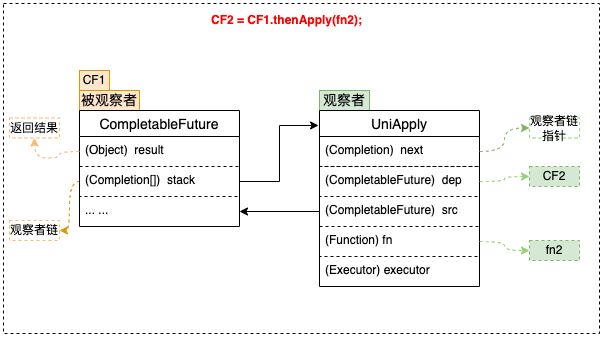
图12 thenApply简图
3.3.1.1 被观察者
- 每个CompletableFuture都可以被看作一个被观察者,其内部有一个Completion类型的链表成员变量stack,用来存储注册到其中的所有观察者。当被观察者执行完成后会弹栈stack属性,依次通知注册到其中的观察者。上面例子中步骤fn2就是作为观察者被封装在UniApply中。
- 被观察者CF中的result属性,用来存储返回结果数据。这里可能是一次RPC调用的返回值,也可能是任意对象,在上面的例子中对应步骤fn1的执行结果。
3.3.1.2 观察者
CompletableFuture支持很多回调方法,例如thenAccept、thenApply、exceptionally等,这些方法接收一个函数类型的参数f,生成一个Completion类型的对象(即观察者),并将入参函数f赋值给Completion的成员变量fn,然后检查当前CF是否已处于完成状态(即result != null),如果已完成直接触发fn,否则将观察者Completion加入到CF的观察者链stack中,再次尝试触发,如果被观察者未执行完则其执行完毕之后通知触发。
- 观察者中的dep属性:指向其对应的CompletableFuture,在上面的例子中dep指向CF2。
- 观察者中的src属性:指向其依赖的CompletableFuture,在上面的例子中src指向CF1。
- 观察者Completion中的fn属性:用来存储具体的等待被回调的函数。这里需要注意的是不同的回调方法(thenAccept、thenApply、exceptionally等)接收的函数类型也不同,即fn的类型有很多种,在上面的例子中fn指向fn2。
3.3.2 整体流程
3.3.2.1 一元依赖
这里仍然以thenApply为例来说明一元依赖的流程:
- 将观察者Completion注册到CF1,此时CF1将Completion压栈。
- 当CF1的操作运行完成时,会将结果赋值给CF1中的result属性。
- 依次弹栈,通知观察者尝试运行。
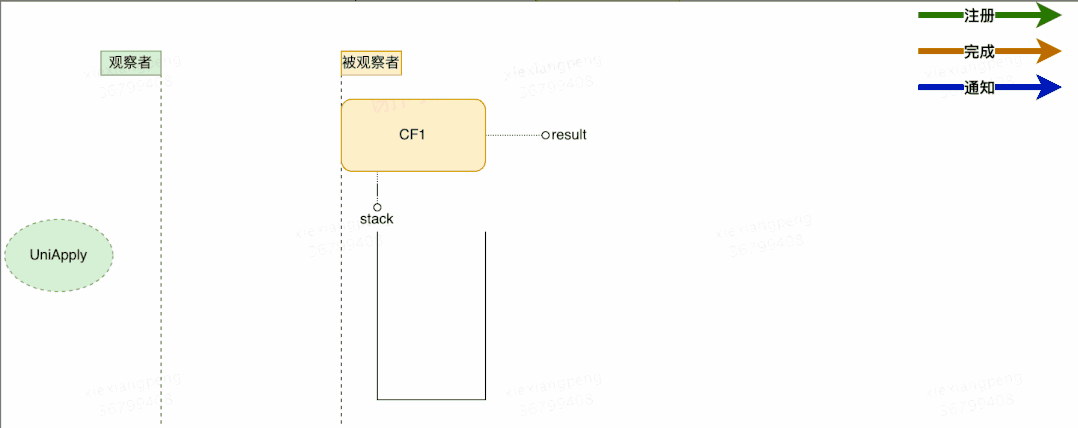
图13 执行流程简要说明
初步流程设计如上图所示,这里有几个关于注册与通知的并发问题,大家可以思考下:Q1:在观察者注册之前,如果CF已经执行完成,并且已经发出通知,那么这时观察者由于错过了通知是不是将永远不会被触发呢 ?A1:不会。在注册时检查依赖的CF是否已经完成。如果未完成(即result == null)则将观察者入栈,如果已完成(result != null)则直接触发观察者操作。Q2:在”入栈“前会有”result == null“的判断,这两个操作为非原子操作,CompletableFufure的实现也没有对两个操作进行加锁,完成时间在这两个操作之间,观察者仍然得不到通知,是不是仍然无法触发?

图14 入栈校验
A2:不会。入栈之后再次检查CF是否完成,如果完成则触发。Q3:当依赖多个CF时,观察者会被压入所有依赖的CF的栈中,每个CF完成的时候都会进行,那么会不会导致一个操作被多次执行呢 ?如下图所示,即当CF1、CF2同时完成时,如何避免CF3被多次触发。
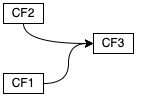
图15 多次触发
A3:CompletableFuture的实现是这样解决该问题的:观察者在执行之前会先通过CAS操作设置一个状态位,将status由0改为1。如果观察者已经执行过了,那么CAS操作将会失败,取消执行。通过对以上3个问题的分析可以看出,CompletableFuture在处理并行问题时,全程无加锁操作,极大地提高了程序的执行效率。我们将并行问题考虑纳入之后,可以得到完善的整体流程图如下所示:
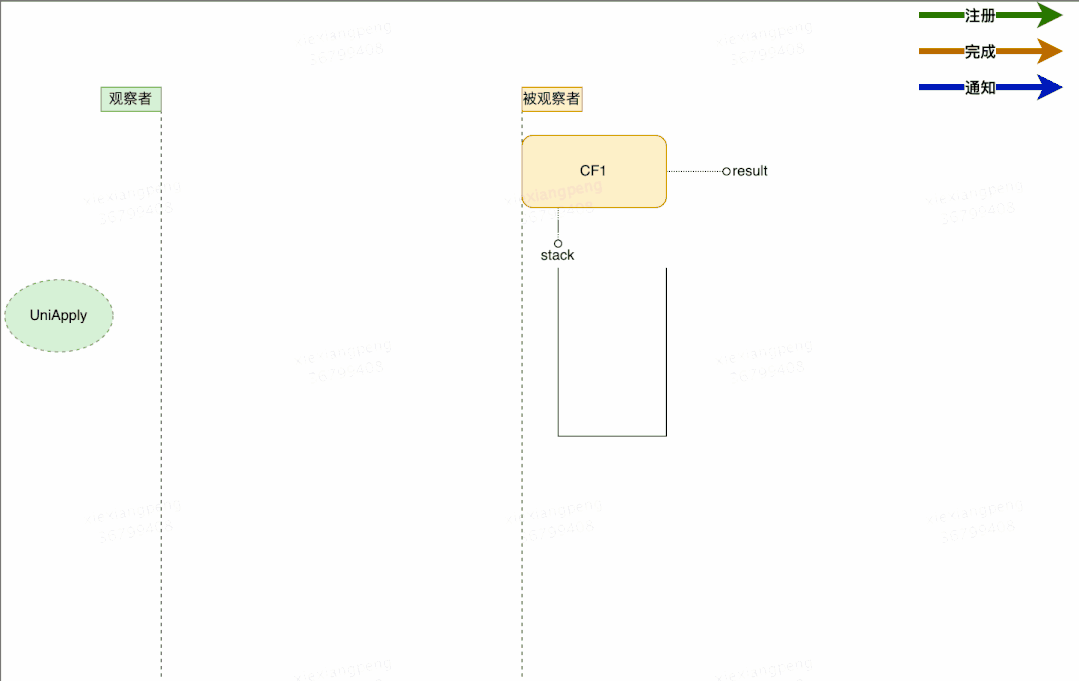
图16 完整流程
CompletableFuture支持的回调方法十分丰富,但是正如上一章节的整体流程图所述,他们的整体流程是一致的。所有回调复用同一套流程架构,不同的回调监听通过策略模式实现差异化。
3.3.2.2 二元依赖
我们以thenCombine为例来说明二元依赖:
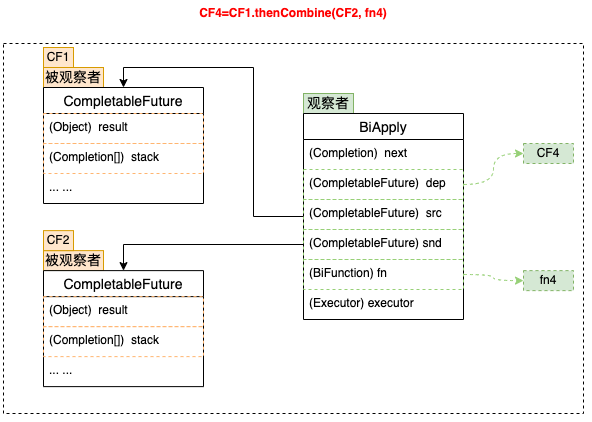
图17 二元依赖数据结构
thenCombine操作表示依赖两个CompletableFuture。其观察者实现类为BiApply,如上图所示,BiApply通过src和snd两个属性关联被依赖的两个CF,fn属性的类型为BiFunction。与单个依赖不同的是,在依赖的CF未完成的情况下,thenCombine会尝试将BiApply压入这两个被依赖的CF的栈中,每个被依赖的CF完成时都会尝试触发观察者BiApply,BiApply会检查两个依赖是否都完成,如果完成则开始执行。这里为了解决重复触发的问题,同样用的是上一章节提到的CAS操作,执行时会先通过CAS设置状态位,避免重复触发。
3.3.2.3 多元依赖
依赖多个CompletableFuture的回调方法包括allOf、anyOf,区别在于allOf观察者实现类为BiRelay,需要所有被依赖的CF完成后才会执行回调;而anyOf观察者实现类为OrRelay,任意一个被依赖的CF完成后就会触发。二者的实现方式都是将多个被依赖的CF构建成一棵平衡二叉树,执行结果层层通知,直到根节点,触发回调监听。
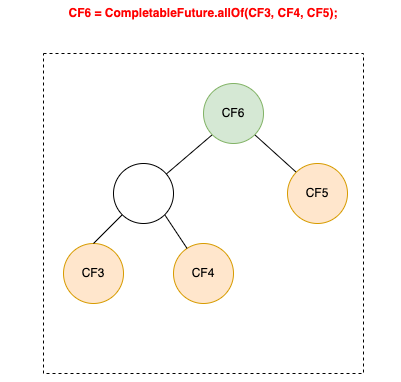
图18 多元依赖结构树
3.3.3 小结
本章节为CompletableFuture实现原理的科普,旨在尝试不粘贴源码,而通过结构图、流程图以及搭配文字描述把CompletableFuture的实现原理讲述清楚。把晦涩的源码翻译为“整体流程”章节的流程图,并且将并发处理的逻辑融入,便于大家理解。
4 实践总结
在商家端API异步化的过程中,我们遇到了一些问题,这些问题有的会比较隐蔽,下面把这些问题的处理经验整理出来。希望能帮助到更多的同学,大家可以少踩一些坑。
4.1 线程阻塞问题
4.1.1 代码执行在哪个线程上?
要合理治理线程资源,最基本的前提条件就是要在写代码时,清楚地知道每一行代码都将执行在哪个线程上。下面我们看一下CompletableFuture的执行线程情况。CompletableFuture实现了CompletionStage接口,通过丰富的回调方法,支持各种组合操作,每种组合场景都有同步和异步两种方法。同步方法(即不带Async后缀的方法)有两种情况。
- 如果注册时被依赖的操作已经执行完成,则直接由当前线程执行。
- 如果注册时被依赖的操作还未执行完,则由回调线程执行。
异步方法(即带Async后缀的方法):可以选择是否传递线程池参数Executor运行在指定线程池中;当不传递Executor时,会使用ForkJoinPool中的共用线程池CommonPool(CommonPool的大小是CPU核数-1,如果是IO密集的应用,线程数可能成为瓶颈)。例如:
ExecutorService threadPool1 = new ThreadPoolExecutor(10, 10, 0L, TimeUnit.MILLISECONDS, new ArrayBlockingQueue<>(100));
CompletableFuture<String> future1 = CompletableFuture.supplyAsync(() -> {
System.out.println("supplyAsync 执行线程:" + Thread.currentThread().getName());
//业务操作
return "";
}, threadPool1);
//此时,如果future1中的业务操作已经执行完毕并返回,则该thenApply直接由当前main线程执行;否则,将会由执行以上业务操作的threadPool1中的线程执行。
future1.thenApply(value -> {
System.out.println("thenApply 执行线程:" + Thread.currentThread().getName());
return value + "1";
});
//使用ForkJoinPool中的共用线程池CommonPool
future1.thenApplyAsync(value -> {
//do something
return value + "1";
});
//使用指定线程池
future1.thenApplyAsync(value -> {
//do something
return value + "1";
}, threadPool1);4.2 线程池须知
4.2.1 异步回调要传线程池
前面提到,异步回调方法可以选择是否传递线程池参数Executor,这里我们建议强制传线程池,且根据实际情况做线程池隔离。当不传递线程池时,会使用ForkJoinPool中的公共线程池CommonPool,这里所有调用将共用该线程池,核心线程数=处理器数量-1(单核核心线程数为1),所有异步回调都会共用该CommonPool,核心与非核心业务都竞争同一个池中的线程,很容易成为系统瓶颈。手动传递线程池参数可以更方便的调节参数,并且可以给不同的业务分配不同的线程池,以求资源隔离,减少不同业务之间的相互干扰。
4.2.2 线程池循环引用会导致死锁
public Object doGet() {
ExecutorService threadPool1 = new ThreadPoolExecutor(10, 10, 0L, TimeUnit.MILLISECONDS, new ArrayBlockingQueue<>(100));
CompletableFuture cf1 = CompletableFuture.supplyAsync(() -> {
//do sth
return CompletableFuture.supplyAsync(() -> {
System.out.println("child");
return "child";
}, threadPool1).join();//子任务
}, threadPool1);
return cf1.join();
}如上代码块所示,doGet方法第三行通过supplyAsync向threadPool1请求线程,并且内部子任务又向threadPool1请求线程。threadPool1大小为10,当同一时刻有10个请求到达,则threadPool1被打满,子任务请求线程时进入阻塞队列排队,但是父任务的完成又依赖于子任务,这时由于子任务得不到线程,父任务无法完成。主线程执行cf1.join()进入阻塞状态,并且永远无法恢复。为了修复该问题,需要将父任务与子任务做线程池隔离,两个任务请求不同的线程池,避免循环依赖导致的阻塞。
4.2.3 异步RPC调用注意不要阻塞IO线程池
服务异步化后很多步骤都会依赖于异步RPC调用的结果,这时需要特别注意一点,如果是使用基于NIO(比如Netty)的异步RPC,则返回结果是由IO线程负责设置的,即回调方法由IO线程触发,CompletableFuture同步回调(如thenApply、thenAccept等无Async后缀的方法)如果依赖的异步RPC调用的返回结果,那么这些同步回调将运行在IO线程上,而整个服务只有一个IO线程池,这时需要保证同步回调中不能有阻塞等耗时过长的逻辑,否则在这些逻辑执行完成前,IO线程将一直被占用,影响整个服务的响应。
4.3 其他
4.3.1 异常处理
由于异步执行的任务在其他线程上执行,而异常信息存储在线程栈中,因此当前线程除非阻塞等待返回结果,否则无法通过try\catch捕获异常。CompletableFuture提供了异常捕获回调exceptionally,相当于同步调用中的try\catch。使用方法如下所示:
@Autowired
private WmOrderAdditionInfoThriftService wmOrderAdditionInfoThriftService;//内部接口
public CompletableFuture<Integer> getCancelTypeAsync(long orderId) {
CompletableFuture<WmOrderOpRemarkResult> remarkResultFuture = wmOrderAdditionInfoThriftService.findOrderCancelledRemarkByOrderIdAsync(orderId);//业务方法,内部会发起异步rpc调用
return remarkResultFuture
.exceptionally(err -> {//通过exceptionally 捕获异常,打印日志并返回默认值
log.error("WmOrderRemarkService.getCancelTypeAsync Exception orderId={}", orderId, err);
return 0;
});
}有一点需要注意,CompletableFuture在回调方法中对异常进行了包装。大部分异常会封装成CompletionException后抛出,真正的异常存储在cause属性中,因此如果调用链中经过了回调方法处理那么就需要用Throwable.getCause()方法提取真正的异常。但是,有些情况下会直接返回真正的异常(Stack Overflow的讨论),最好使用工具类提取异常,如下代码所示:
@Autowired
private WmOrderAdditionInfoThriftService wmOrderAdditionInfoThriftService;//内部接口
public CompletableFuture<Integer> getCancelTypeAsync(long orderId) {
CompletableFuture<WmOrderOpRemarkResult> remarkResultFuture = wmOrderAdditionInfoThriftService.findOrderCancelledRemarkByOrderIdAsync(orderId);//业务方法,内部会发起异步rpc调用
return remarkResultFuture
.thenApply(result -> {//这里增加了一个回调方法thenApply,如果发生异常thenApply内部会通过new CompletionException(throwable) 对异常进行包装
//这里是一些业务操作
})
.exceptionally(err -> {//通过exceptionally 捕获异常,这里的err已经被thenApply包装过,因此需要通过Throwable.getCause()提取异常
log.error("WmOrderRemarkService.getCancelTypeAsync Exception orderId={}", orderId, ExceptionUtils.extractRealException(err));
return 0;
});
}上面代码中用到了一个自定义的工具类ExceptionUtils,用于CompletableFuture的异常提取,在使用CompletableFuture做异步编程时,可以直接使用该工具类处理异常。实现代码如下:
public class ExceptionUtils {
public static Throwable extractRealException(Throwable throwable) {
//这里判断异常类型是否为CompletionException、ExecutionException,如果是则进行提取,否则直接返回。
if (throwable instanceof CompletionException || throwable instanceof ExecutionException) {
if (throwable.getCause() != null) {
return throwable.getCause();
}
}
return throwable;
}
}4.3.2 沉淀的工具方法介绍
在实践过程中我们沉淀了一些通用的工具方法,在使用CompletableFuture开发时可以直接拿来使用,详情参见“附录”。
5 异步化收益
通过异步化改造,美团商家端API系统的性能得到明显提升,与改造前对比的收益如下:
- 核心接口吞吐量大幅提升,其中订单轮询接口改造前TP99为754ms,改造后降为408ms。
- 服务器数量减少1/3。
6 参考文献
- CompletableFuture (Java Platform SE 8 )
- java - Does CompletionStage always wrap exceptions in CompletionException? - Stack Overflow
- exception - Surprising behavior of Java 8 CompletableFuture exceptionally method - Stack Overflow
- 文档 | Apache Dubbo
7 名词解释及备注
注1:“增量同步”是指商家客户端与服务端之间的订单增量数据同步协议,客户端使用该协议获取新增订单以及状态发生变化的订单。注2:本文涉及到的所有技术点依赖的Java版本为JDK 8,CompletableFuture支持的特性分析也是基于该版本。
自定义函数
@FunctionalInterface
public interface ThriftAsyncCall {
void invoke() throws TException ;
}CompletableFuture处理工具类
/**
* CompletableFuture封装工具类
*/
@Slf4j
public class FutureUtils {
/**
* 该方法为美团内部rpc注册监听的封装,可以作为其他实现的参照
* OctoThriftCallback 为thrift回调方法
* ThriftAsyncCall 为自定义函数,用来表示一次thrift调用(定义如上)
*/
public static <T> CompletableFuture<T> toCompletableFuture(final OctoThriftCallback<?,T> callback , ThriftAsyncCall thriftCall) {
CompletableFuture<T> thriftResultFuture = new CompletableFuture<>();
callback.addObserver(new OctoObserver<T>() {
@Override
public void onSuccess(T t) {
thriftResultFuture.complete(t);
}
@Override
public void onFailure(Throwable throwable) {
thriftResultFuture.completeExceptionally(throwable);
}
});
if (thriftCall != null) {
try {
thriftCall.invoke();
} catch (TException e) {
thriftResultFuture.completeExceptionally(e);
}
}
return thriftResultFuture;
}
/**
* 设置CF状态为失败
*/
public static <T> CompletableFuture<T> failed(Throwable ex) {
CompletableFuture<T> completableFuture = new CompletableFuture<>();
completableFuture.completeExceptionally(ex);
return completableFuture;
}
/**
* 设置CF状态为成功
*/
public static <T> CompletableFuture<T> success(T result) {
CompletableFuture<T> completableFuture = new CompletableFuture<>();
completableFuture.complete(result);
return completableFuture;
}
/**
* 将List<CompletableFuture<T>> 转为 CompletableFuture<List<T>>
*/
public static <T> CompletableFuture<List<T>> sequence(Collection<CompletableFuture<T>> completableFutures) {
return CompletableFuture.allOf(completableFutures.toArray(new CompletableFuture<?>[0]))
.thenApply(v -> completableFutures.stream()
.map(CompletableFuture::join)
.collect(Collectors.toList())
);
}
/**
* 将List<CompletableFuture<List<T>>> 转为 CompletableFuture<List<T>>
* 多用于分页查询的场景
*/
public static <T> CompletableFuture<List<T>> sequenceList(Collection<CompletableFuture<List<T>>> completableFutures) {
return CompletableFuture.allOf(completableFutures.toArray(new CompletableFuture<?>[0]))
.thenApply(v -> completableFutures.stream()
.flatMap( listFuture -> listFuture.join().stream())
.collect(Collectors.toList())
);
}
/*
* 将List<CompletableFuture<Map<K, V>>> 转为 CompletableFuture<Map<K, V>>
* @Param mergeFunction 自定义key冲突时的merge策略
*/
public static <K, V> CompletableFuture<Map<K, V>> sequenceMap(
Collection<CompletableFuture<Map<K, V>>> completableFutures, BinaryOperator<V> mergeFunction) {
return CompletableFuture
.allOf(completableFutures.toArray(new CompletableFuture<?>[0]))
.thenApply(v -> completableFutures.stream().map(CompletableFuture::join)
.flatMap(map -> map.entrySet().stream())
.collect(Collectors.toMap(Entry::getKey, Entry::getValue, mergeFunction)));
}
/**
* 将List<CompletableFuture<T>> 转为 CompletableFuture<List<T>>,并过滤调null值
*/
public static <T> CompletableFuture<List<T>> sequenceNonNull(Collection<CompletableFuture<T>> completableFutures) {
return CompletableFuture.allOf(completableFutures.toArray(new CompletableFuture<?>[0]))
.thenApply(v -> completableFutures.stream()
.map(CompletableFuture::join)
.filter(e -> e != null)
.collect(Collectors.toList())
);
}
/**
* 将List<CompletableFuture<List<T>>> 转为 CompletableFuture<List<T>>,并过滤调null值
* 多用于分页查询的场景
*/
public static <T> CompletableFuture<List<T>> sequenceListNonNull(Collection<CompletableFuture<List<T>>> completableFutures) {
return CompletableFuture.allOf(completableFutures.toArray(new CompletableFuture<?>[0]))
.thenApply(v -> completableFutures.stream()
.flatMap( listFuture -> listFuture.join().stream().filter(e -> e != null))
.collect(Collectors.toList())
);
}
/**
* 将List<CompletableFuture<Map<K, V>>> 转为 CompletableFuture<Map<K, V>>
* @Param filterFunction 自定义过滤策略
*/
public static <T> CompletableFuture<List<T>> sequence(Collection<CompletableFuture<T>> completableFutures,
Predicate<? super T> filterFunction) {
return CompletableFuture.allOf(completableFutures.toArray(new CompletableFuture<?>[0]))
.thenApply(v -> completableFutures.stream()
.map(CompletableFuture::join)
.filter(filterFunction)
.collect(Collectors.toList())
);
}
/**
* 将List<CompletableFuture<List<T>>> 转为 CompletableFuture<List<T>>
* @Param filterFunction 自定义过滤策略
*/
public static <T> CompletableFuture<List<T>> sequenceList(Collection<CompletableFuture<List<T>>> completableFutures,
Predicate<? super T> filterFunction) {
return CompletableFuture.allOf(completableFutures.toArray(new CompletableFuture<?>[0]))
.thenApply(v -> completableFutures.stream()
.flatMap( listFuture -> listFuture.join().stream().filter(filterFunction))
.collect(Collectors.toList())
);
}
/**
* 将CompletableFuture<Map<K,V>>的list转为 CompletableFuture<Map<K,V>>。 多个map合并为一个map。 如果key冲突,采用新的value覆盖。
*/
public static <K, V> CompletableFuture<Map<K, V>> sequenceMap(
Collection<CompletableFuture<Map<K, V>>> completableFutures) {
return CompletableFuture
.allOf(completableFutures.toArray(new CompletableFuture<?>[0]))
.thenApply(v -> completableFutures.stream().map(CompletableFuture::join)
.flatMap(map -> map.entrySet().stream())
.collect(Collectors.toMap(Entry::getKey, Entry::getValue, (a, b) -> b)));
}}异常提取工具类
public class ExceptionUtils {
/**
* 提取真正的异常
*/
public static Throwable extractRealException(Throwable throwable) {
if (throwable instanceof CompletionException || throwable instanceof ExecutionException) {
if (throwable.getCause() != null) {
return throwable.getCause();
}
}
return throwable;
}
} @Slf4j
public abstract class AbstractLogAction<R> {
protected final String methodName;
protected final Object[] args;
public AbstractLogAction(String methodName, Object... args) {
this.methodName = methodName;
this.args = args;
}
protected void logResult(R result, Throwable throwable) {
if (throwable != null) {
boolean isBusinessError = throwable instanceof TBase || (throwable.getCause() != null && throwable
.getCause() instanceof TBase);
if (isBusinessError) {
logBusinessError(throwable);
} else if (throwable instanceof DegradeException || throwable instanceof DegradeRuntimeException) {//这里为内部rpc框架抛出的异常,使用时可以酌情修改
if (RhinoSwitch.getBoolean("isPrintDegradeLog", false)) {
log.error("{} degrade exception, param:{} , error:{}", methodName, args, throwable);
}
} else {
log.error("{} unknown error, param:{} , error:{}", methodName, args, ExceptionUtils.extractRealException(throwable));
}
} else {
if (isLogResult()) {
log.info("{} param:{} , result:{}", methodName, args, result);
} else {
log.info("{} param:{}", methodName, args);
}
}
}
private void logBusinessError(Throwable throwable) {
log.error("{} business error, param:{} , error:{}", methodName, args, throwable.toString(), ExceptionUtils.extractRealException(throwable));
}
private boolean isLogResult() {
//这里是动态配置开关,用于动态控制日志打印,开源动态配置中心可以使用nacos、apollo等,如果项目没有使用配置中心则可以删除
return RhinoSwitch.getBoolean(methodName + "_isLogResult", false);
}}日志处理实现类
/**
* 发生异常时,根据是否为业务异常打印日志。
* 跟CompletableFuture.whenComplete配合使用,不改变completableFuture的结果(正常OR异常)
*/
@Slf4j
public class LogErrorAction<R> extends AbstractLogAction<R> implements BiConsumer<R, Throwable> {
public LogErrorAction(String methodName, Object... args) {
super(methodName, args);
}
@Override
public void accept(R result, Throwable throwable) {
logResult(result, throwable);
}
}打印日志方式
completableFuture
.whenComplete(
new LogErrorAction<>("orderService.getOrder", params));异常情况返回默认值
/**
* 当发生异常时返回自定义的值
*/
public class DefaultValueHandle<R> extends AbstractLogAction<R> implements BiFunction<R, Throwable, R> {
private final R defaultValue;
/**
* 当返回值为空的时候是否替换为默认值
*/
private final boolean isNullToDefault;
/**
* @param methodName 方法名称
* @param defaultValue 当异常发生时自定义返回的默认值
* @param args 方法入参
*/
public DefaultValueHandle(String methodName, R defaultValue, Object... args) {
super(methodName, args);
this.defaultValue = defaultValue;
this.isNullToDefault = false;
}
/**
* @param isNullToDefault
* @param defaultValue 当异常发生时自定义返回的默认值
* @param methodName 方法名称
* @param args 方法入参
*/
public DefaultValueHandle(boolean isNullToDefault, R defaultValue, String methodName, Object... args) {
super(methodName, args);
this.defaultValue = defaultValue;
this.isNullToDefault = isNullToDefault;
}
@Override
public R apply(R result, Throwable throwable) {
logResult(result, throwable);
if (throwable != null) {
return defaultValue;
}
if (result == null && isNullToDefault) {
return defaultValue;
}
return result;
}
public static <R> DefaultValueHandle.DefaultValueHandleBuilder<R> builder() {
return new DefaultValueHandle.DefaultValueHandleBuilder<>();
}
public static class DefaultValueHandleBuilder<R> {
private boolean isNullToDefault;
private R defaultValue;
private String methodName;
private Object[] args;
DefaultValueHandleBuilder() {
}
public DefaultValueHandle.DefaultValueHandleBuilder<R> isNullToDefault(final boolean isNullToDefault) {
this.isNullToDefault = isNullToDefault;
return this;
}
public DefaultValueHandle.DefaultValueHandleBuilder<R> defaultValue(final R defaultValue) {
this.defaultValue = defaultValue;
return this;
}
public DefaultValueHandle.DefaultValueHandleBuilder<R> methodName(final String methodName) {
this.methodName = methodName;
return this;
}
public DefaultValueHandle.DefaultValueHandleBuilder<R> args(final Object... args) {
this.args = args;
return this;
}
public DefaultValueHandle<R> build() {
return new DefaultValueHandle<R>(this.isNullToDefault, this.defaultValue, this.methodName, this.args);
}
public String toString() {
return "DefaultValueHandle.DefaultValueHandleBuilder(isNullToDefault=" + this.isNullToDefault + ", defaultValue=" + this.defaultValue + ", methodName=" + this.methodName + ", args=" + Arrays.deepToString(this.args) + ")";
}
}默认返回值应用示例
completableFuture.handle(new DefaultValueHandle<>("orderService.getOrder", Collections.emptyMap(), params));长发、旭孟、向鹏,均来自美团外卖商家组技术团队。
Recommend
About Joyk
Aggregate valuable and interesting links.
Joyk means Joy of geeK